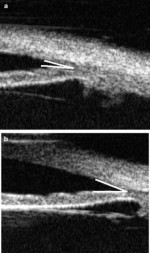Laser Procedures
Several types of lasers are used to treat eye disease in ophthalmology. They are generally performed in the office on an outpatient basis.
Laser Vision Correction
Laser can be used to correct near-sightedness, far-sightedness, or astigmatism, and eleminate or reduce the need to use glasses or contact lenses. There are two main types of laser vision correction, LASIK and PRK. Please call us to schedule a consultation!
Laser Trabeculoplasty
Laser trabeculoplasty involves the use of laser (red spot) to open up the natural drain of the eye called trabecular meshwork (brown band between the arrows). It is an office based laser procedure and can lower the intraocular pressure by up to 25% in glaucoma patients to slow disease progression. It can be used as a primary treatment or as an adjunct to medical therapy.
Peripheral Laser Iridotomy and Laser Iridoplasty
In narrow angle, the iris is too close to the cornea and the drainage channel of the eye, called the trabecular meshwork, is at risk for obstruction if the iris and cornea come into contact with
each other (top photo). An opening is created on the iris (laser iridotomy) to push the iris backwards away from the cornea (bottom photo) to prevent the occurrence of an acute angle closure
attack. Sometimes when the angle is extremely narrow, laser iridoplasty is also performed to make the iris thinner in order to open the angle further. If an attack occurs, one may
exprience redness, blurry vision, pain, nausea, vomiting, and potential permanent loss of vision.
YAG Capsulotomy
After cataract surgery, the lens implants sits inside a capsule inside the eye. This capsule may sometime become opacified over time. The film can cause blurry vision or glare and can
be removed by laser treatment. Newer lens designs have reduced its occurence.
Retinal Photocoagulation
Uncontrolled diabetes can cause retinal hemorrhages (bleeding) and edema (swelling), resulting in decreased vision. Lasers can be used to prevent or reduce the amount of hemorrhage and edema and preserve visual function. In proliferative diabetic retinopathy, a large hemorrhage can cause blood to fill the eye. Pan retinal photocoagulation can be used to pevent its occurrance. In cases of retinal tear, barricade laser is used to prevent extension and retinal detachment.





